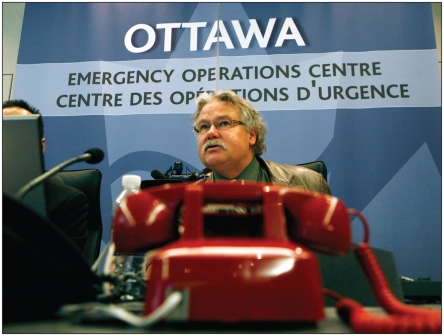University of Manitoba Associate Professor of Medicine Dr. Anand Kumar boils it down to a simple case of bureaucracy versus good health care in any outbreak of pandemic (H1N1) 2009.
It’s an issue that has been brewing for weeks: Should community health workers, paramedics or other officials within remote communities be allowed to dispense antivirals to flu-stricken residents during an outbreak, in cases where no doctor or registered nurse is available?
Arguments against the notion have been numerous. It risks people mistakenly getting antivirals when they haven’t been properly diagnosed and should actually be treated for another condition. It steps on the prescribing authority of doctors. It somehow implies that people in remote communities are being provided a standard of care.
But for people infected with the H1N1 virus, the evidence suggests that every single day they don’t get oseltamivir places their health at greater risk, argues Kumar, who at a national pandemic conference in Winnipeg, Manitoba, in September urged Public Health Agency of Canada (PHAC) Chief Health Officer Dr. David Butler–Jones to loosen restrictions on distributing oseltamivir in remote communities.
“There’s an emerging body of evidence that suggests the speed with which antiviral therapy is initiated after symptom onset is actually related to the degree of severity of disease that people present with, if they deterioriate,” Kumar says.
Given that link, it only makes sense that the federal and provincial governments move with programs or some manner of prescriptive exemption to allow for local dispensing of oseltamivir in cases where a doctor or registered nurse is unavailable in remote and underserviced areas in epidemic conditions, he says.
Kumar says the United Kingdom has a program that allows people to contact call centres, describe their symptoms and get a prescription, which a family member or friend can pick up.
Canada’s Chief Public Health Officer Dr. David Butler–Jones has been asked to loosen restrictions on dispensing oseltamivir in remote communities.
The simplest solution, he says, would be to have antivirals “prepositioned” within remote communities and have them distributed by a “responsible” local official who’s in telephone contact with physicians. “You hand it out if people meet the symptoms and in the interim, you can start to transport them out for assessment. God knows, I don’t think you should be waiting a week to get treatment.”
Public health authorities have been seeking some such manner of programming or a prescriptive exemption from PHAC for months, to little avail.
But sources say the federal government is now contemplating a number of options — including a program to fly doctors into outbreak sites or a prescriptive exemption — and will likely announce its preference, so as to resolve the matter before the flu season is rampant.
Vancouver Island outbreak
The pandemic (H1N1) 2009 outbreak on Vancouver Island may actually be more severe than originally believed.
Vancouver Island Health Authority Chief Medical Officer Dr. Richard Stanwick told Canadian Press that a resident of the southern end of the island died from the H1N1 virus.
Meanwhile, Dr. Charmaine Enns, a medical officer of health and medical director for aboriginal health for the authority, says the outbreak has not been confined to Tofino and nearby aboriginal communities like Ahousat. “It’s in all of our communities on Vancouver Island,” she stresses.
Moreover, Vancouver Island is no different than any other region of Canada, she adds. “For us to not think that H1N1 is not in any of our communities is completely naive. In British Columbia, we have asked our community physicians not to do community swabbing, because it’s here. If you have influenza-like illness during the summer, it’s most likely swine flu. So we’re not interested in swabbing in the general community. We have been doing extra swabbing in our more remote communities so that we have more information in terms of being able to respond from a community perspective. So you are not knowing about, nor are you hearing about, nor are we counting in Canada, community cases of H1N1.”
Asked how many H1N1 cases have been confirmed on the Island, Enns replied, “I don’t know. Why does that even matter? We’re not counting confirmed cases. We’re really only looking in the hospitals for people who are severely ill and hospitalized. That’s the reality. The reality is that we told our community doctors months ago: Stop swabbing in the general population because H1N1 is here. The horse is out of the barn.”
“For somebody who has influenza-like illness in Tofino, for somebody who has influenza-like illness in Victoria, for somebody who has influenza-like illness in Toronto, it’s probably swine flu. But we’re not counting them. For every lab-confirmed case, we expect probably 30 cases of community H1N1s associated with it.”
Enns stressed that the important thing is that people infected with the H1N1 virus received the treatment they needed, while community and health officials responded appropriately under the authority’s pandemic preparedness plan.
“We are all doing the right thing,” Enns says, adding that identifying any specific Aboriginal community as the site of an H1N1 outbreak, when all Island communities have people infected, generates “chaos, increased anxiety, stress, potential stigmatization of a community that does not need to be stigmatized because, in fact, everything in Ahousat is under control, as it is in all the other communities that have reported H1N1 in them.”



